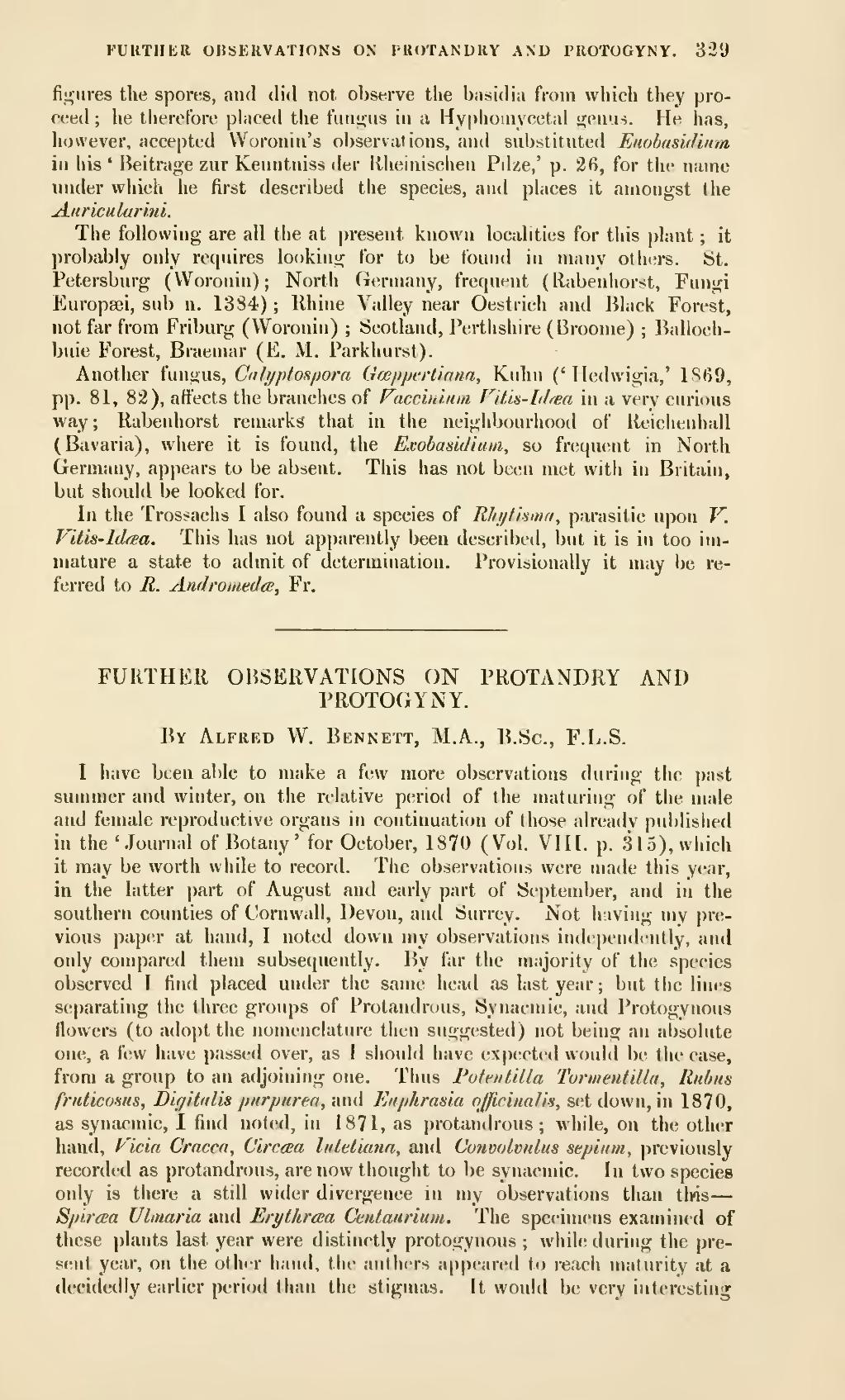FURTHER OBSERVATIONS ON PROTANDRY AND PROTOGYNY. 339
fi^-iires the spores, and did not observe the basic) i;i from which they pro- ceed; he therefore phiced the funi>-iis in a Hyphoinycetal j^enus. He has, however, accepted VVoroniu's observations, and siibstitnted Eaohasidinm in his ' Beitrage zur Kenntniss der ilheinischen Pdze,' p. 26, for the name nnder wiiich he first described the species, and places it amongst the Auriculurini.
The following are all the at present known localities for this plant; it probably only requires looking for to be found in many others. St. Petersburg (VVoronin); North Germany, frequent (Rabenhorst, Fungi Europsei, sub n. 13S4); Khine Valley near Oestrich and Black Forest, not far from Friburg (Woronin); Scotland, I'erthshire (Broome); Balloch- buie Forest, Braeinar (E. M. Parkhurst).
Another fungus, Cnlyptospoi-a Gfjeppertiana, Kuhn (' Hedwigia,' 1869, pp. 81, 82), affects the branches of Faccinuim Fitls-Idrea in a very curious way; Rabenhorst remarks that in the neighbourhood of ileichenhall (Bavaria), where it is found, the Exobasidiuni, so frequent in North Germany, appears to be absent. This has not been met with in Britain, but should be looketl for.
In the Trossachs I also found a species of RJi/jfisina, parasitic upon V. Vitis-Id^a. This has not apparently been described, but it is in too im- mature a state to admit of determination. Provisionally it may be re- ferred to R. Androuiedce, Fr.
��FURTHEE OBSERVATIONS ON PROTANDRY AND PROTOGYNY.
By Alfred W. Bennett, M.A., B.Sc, F.L.S.
I have been able to make a few more observations during the past summer and winter, on the relative period of the maturing of the nuile and female reproductive organs in continuation of those already puijlislied in the 'Journal of Botany ' for October, 1870 (Vol. VIII. p. 315), which it may be worth while to record. The observations were made this year, in the latter part of August and early part of September, and in the southern counties of Cornwall, Devon, and Surrey. Not having my pre- vious paper at hand, I noted down my observations independently, and only compared them subsequently. liy far the majority of the species observed I hnd placed under the same head as last year; but the lines separating the three groups of Prolandrous, Synacmie, and Protogynous ilowcrs (to adopt the nomenclature then suggested) not being an absolute one, a few have passed over, as 1 should have ex|)ected would be the case, from a group to an adjoining one. Thus Putodllla Turmeutilla, Riihiis frnticosus, D'u/itnlls picrpiiren, and Euphrasia nJficinaHs, set down, in 1870, as synacmie, I find noted, in 1871, as jjrotandrous; while, on the other band, Ficia Cracca, Circcea lutetlana, and Convolvulus sepintn, previously recorded as protandrous, are now thought to be synacmie. In two species only is there a still wider divergence in my observations than tins — Spiraa Ulmaria and Enjlkraa Centaiirium. The specimens examined of these plants last year were distinctly protogynous; while during the pre- sent year, on the other hand, the anthers appeared to reach maturity at a decidedly earlier period than the stigmas. It would be very interesting
�� �
